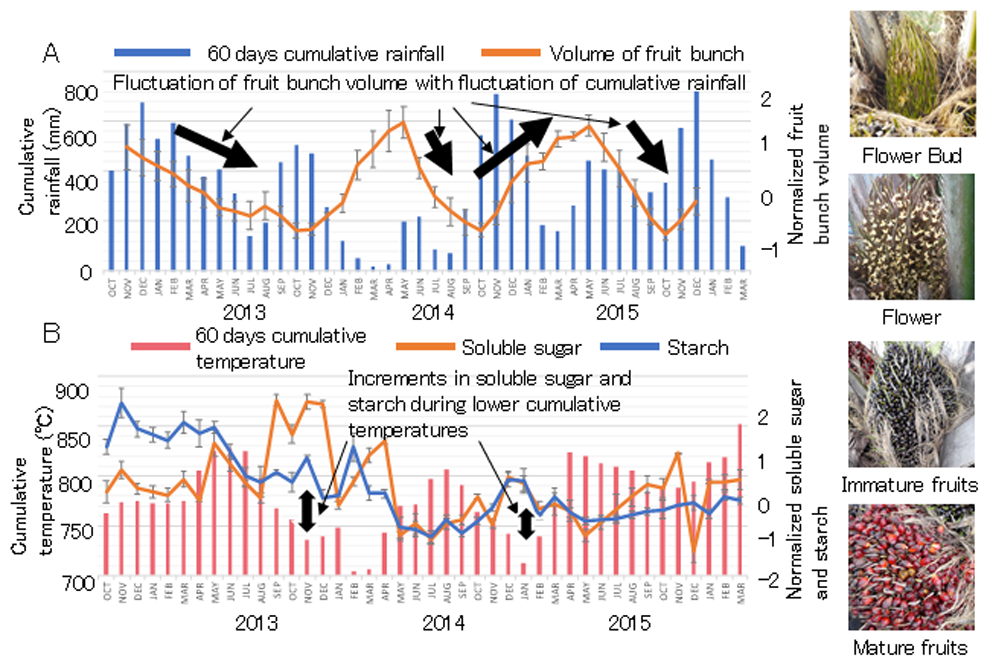Main factors that determine the amounts of soluble sugar and starch in old oil palm trunk
Description
Palm oil occupies 40% of global vegetable oil production, with 85% of all palm oil production confined to a restricted area that is primarily within Indonesia and Malaysia. Oil palm stem contributes a large proportion of the waste, but its sap contains approximately 11% soluble sugar. Non-structural carbohydrates (NSC), including soluble sugars and starch in the stem, can be used as a substrate in bioreactors and so on. Although soluble sugar content in the sap of felled trunk was identified to be dependent on the amount of starch (JIRCAS Research Highlights 2017, C07), the mechanisms through which NSC accumulate in the stem have not yet been well documented. Oil palm cultivation is limited in the surrounding area of the equator, hence it has been considered that water stress due to high temperature and drought affects productivity of fruit bunches, which leads to the seasonality of production. Here, we investigated how environmental conditions influence NSC in stem and fruits as intermediate and final storages. These findings should contribute to the stable production of palm oil as well as the utilization of NSC from the stem in downstream applications.
The volume of fruit bunch increased from around October, reaching maximum around May the following year, then matured fruit bunches dropped. Increments in soluble sugar levels were observed but increments in starch levels were not obvious during periods when there were less fruit bunches (Fig. 1). Convergent cross mapping (CCM), an analytical method in empirical dynamic modeling to identify causal relationship between time-series showing non-linear dynamic, showed a causal relationship between soluble sugar in stem and volume of fruit bunch. Furthermore, CCM showed that the 60-day cumulative temperature taken backward from the observation dates (CT) was causally and strongly related to soluble sugar and starch in stem with about a half-year time lag, but not to volume of fruit bunch. Similarly, 60-day cumulative rainfall taken backward from the observation dates (CR) was causally related to soluble sugar and starch in stem with no time lag (Fig. 2).
The above results suggest that the main factors that determine soluble sugar and starch in the stem are temperature and subsequently rainfall fluctuations. The period from October to December, when lower temperatures and higher cumulative rainfall are observed in the northern part of Malay peninsula where the study was conducted, was identified as the period with maximum stem NSC stocks. This finding can contribute to planning the timing of tree felling operations to maximize soluble sugar and starch in old oil palm stem for downstream usage in biorefineries. When the finding is applied to other regions, it is necessary to identify environmental factors indicating strong causality and its time lags.
Figure, table
-
Fig 1. The volume of fruit bunch summed from all development stages, shown by photos on the right side, and 60 days cumulative rainfall (A), the amounts of soluble sugar and starch in oil palm stem and 60 days cumulative temperature during the observation period (B) -
Fig. 2. Significant causal relationship from cumulative temperature and rainfall to soluble sugar, starch in oil palm stem, and volume of fruit bunch evaluated by empirical dynamic modelling
- Affiliation
-
Japan International Research Center for Agricultural Sciences Forestry Division
- Classification
-
Technical A
- Research project
- Program name
- Term of research
-
FY2019 (FY2016-FY2020)
- Responsible researcher
-
Tani Naoki ( Forestry Division )
KAKEN Researcher No.: 90343798Kosugi Akihiko ( Biological Resources and Post-harvest Division )
Arai Takamitsu ( Biological Resources and Post-harvest Division )
MIERUKA ID: 001768Kondo Toshiaki ( Biological Resources and Post-harvest Division )
KAKEN Researcher No.: 40391106Abdul Hamid Zubaidah Aimi ( Universiti Sains Malaysia )
Joseph Natra ( Universiti Sains Malaysia )
Sulaiman Othman ( Universiti Sains Malaysia )
Satake Akiko ( Kyushu University )
KAKEN Researcher No.: 70506237 - ほか
- Publication, etc.
-
https://doi.org/10.1038/s41598-019-57170-8
Tani N et al. (2020) Scientific Reports, 10:650
- Japanese PDF
-
2019_C03_A3_ja.pdf354.76 KB
- English PDF
-
2019_C03_A4_en.pdf577.88 KB
2019_C03_A3_en.pdf272.21 KB
- Poster PDF
-
2019_C03_poster_fin.pdf403.23 KB


